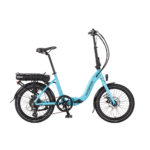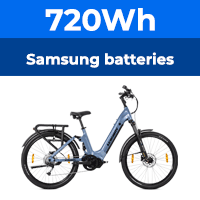Hi all, hoping one of you fine people can help with my scooter problem. I have a 48v 200w brushless hub motor with hall sensors. I have tested the following with a multi-meter. Throttle getting a signal between 0v to 5v so is working. the hall sensors all 3 working as they should. controller is giving out the power to the motor as it should and the batteries are all good and charged (I use them on my Sakura so they are definately good) tested anyway and kicking out 48/49v. there seems to be no logical reason the motor shouldnt turn but it wont. I have noticed though when I have no power switched on the motor wheel freewheels with little effort, when I switch power on the motor wheel is hard to turn but still wont spin on the throttle. Anybody any ideas or clues I should try. The bike is a chinese moped/scooter type made by ZHEJIANG SHUANGCHAO SPORTS LTD MODEL: PB706 looks a lot like a vespa. Many thanks in advance.
A Head Scratcher for you
- Thread starter roleup
- Start date
D
Deleted member 4366
Guest
Sounds a bit like one or more shorted FETs in your controller.
Here's something about how to test them. You might find a clearer description if you Google it.
Endless-sphere.com • View topic - How do i test FETS without removing?
If you get a new controller, don't use full throttle until yo're sure the phase/hall sequence is correct.
Here's something about how to test them. You might find a clearer description if you Google it.
Endless-sphere.com • View topic - How do i test FETS without removing?
If you get a new controller, don't use full throttle until yo're sure the phase/hall sequence is correct.
Sounds a bit like one or more shorted FETs in your controller.
Here's something about how to test them. You might find a clearer description if you Google it.
Endless-sphere.com • View topic - How do i test FETS without removing?
If you get a new controller, don't use full throttle until yo're sure the phase/hall sequence is correct.
So if I do buy a new controller do I have to sync it somehow to set the hall sensors or do you just plug it in and it will work. Never heard of FETs so will have a go at testing them now. Thanks for the info also going to test the brake sensors to see if they are somehow stopping the motor.
D
Deleted member 4366
Guest
Don't waste your time resting the brake sensors. The FETs are the black things inside the controller. If you can post some decent photos, once you've opened it up, I can probably help further.
Some controllers have automatic detection of phase and hall wire connections, others are fixed. The fixed ones don't always match colour to colour, so you have to do a bit of experimentation sometimes, but if you open the throttle wide with the wrong sequence, it can blow your FETs because it's like having a stalled motor: The power goes in, but the motor can't turn.
Any time anybody gets a new controller, they should always be gentle on the throttle until they're sure that the motor responds properly. The other things that can blow FETs is melted insulation on the phase bullet connectors, chafed phase wires, faulty connection to a phase wire and labouring the motor up steep hills.
Some controllers have automatic detection of phase and hall wire connections, others are fixed. The fixed ones don't always match colour to colour, so you have to do a bit of experimentation sometimes, but if you open the throttle wide with the wrong sequence, it can blow your FETs because it's like having a stalled motor: The power goes in, but the motor can't turn.
Any time anybody gets a new controller, they should always be gentle on the throttle until they're sure that the motor responds properly. The other things that can blow FETs is melted insulation on the phase bullet connectors, chafed phase wires, faulty connection to a phase wire and labouring the motor up steep hills.
Oh dear d8veh I killed my Sakura the other day I havent really checked it as I had to leave it at a friends but basically it just stopped working (fully charged) but I do live in a hilly area and can not peddle as I had a recent motorbike accident and after 3 operations on my knee I can not bend my leg so cant peddle hence why I went down the scooter route as opposed to cycle. My wife insisted I sold my motorbikes which I have and needed transport. Thats how I ended up down the electric bike route I think they are fantastic and have saved me a small fortune in taxi fares to the doctors etc. Only problem in UK is 200w max unless you insure etc and as I am unable to work cant afford to pay all that. I think I have tested the fets (mosfets i beleive i have tested via google) but am unsure as new to all this only guided by your kind self and google. I will take the controller off and post a few pics any advice would be greatfully appreciated.
D
Deleted member 4366
Guest
You can only test the FETs inside the controller.
Some of these 200w scooters have 500w motors in them. You can often get a lot more power with a bigger controller at the expense of distance.
Some of these 200w scooters have 500w motors in them. You can often get a lot more power with a bigger controller at the expense of distance.
Last edited by a moderator:
Slightly off topic of actually fixing the bikes you have..... But
If your need to use a bike up steep hills without pedalling then maybe a crank drive based bike (with throttle as well as PAS) might be an option for you. Better for dealing with steep hills without overstressing the motor as they use the bikes gears
If your need to use a bike up steep hills without pedalling then maybe a crank drive based bike (with throttle as well as PAS) might be an option for you. Better for dealing with steep hills without overstressing the motor as they use the bikes gears
Managed to get the controller open no idea what anything is in here so any assistance would be greatful.
Attachments
-
85.8 KB Views: 19
-
91 KB Views: 16
-
87.9 KB Views: 16
-
90.5 KB Views: 18
D
Deleted member 4366
Guest
The FETs are the 6 upright things that clamp to the side of the controller. Looking at them from the front (black side), the Gate is the left leg, the Source is the middle leg and the Drain is the right leg.
First test is to measure the resistance between the source and the drain on each FET. The resistance should be high. If it's shorted, you'll get a low resistance.
I forgot to mention: Oviously you need to check them for any sign of burning.
First test is to measure the resistance between the source and the drain on each FET. The resistance should be high. If it's shorted, you'll get a low resistance.
I forgot to mention: Oviously you need to check them for any sign of burning.
Last edited by a moderator:
Thanks d8veh but I am from thicksville when it comes to electrics so can you advise what I do with the multi-meter I have attached a photo (not a great one) let me know what I should put it on and what to probe. I really appreciate your advice on this.
Attachments
-
77 KB Views: 10
D
Deleted member 4366
Guest
hi d8veh no signs of burning but as you have advised above i am getting mixed readings if i am testing correctly seems though that I am getting low readings and high which from what you have stated seems to be goosed. Do you think I should purchase another controller as to be honest I dont think I have the skills to repair this one. also what was interesting that you said if my motor is higher than a 200w stated manufacturor. If I was to say buy a 350w controller would in your opinion be better for my situation with my leg etc bare in mind I only do about 4/5 miles when I am out and about. Just gives me the edge on the hills at the cost of battery zap!
D
Deleted member 4366
Guest
Some FEts should be higher than others. 6K should be about the minimum. Anything less than 1K is defective.
Can you take a photo of your motor wheel? Is there any writing on the controller box that indicates power?
Just to eliminate it, you should also test the motor. Put your meter on "beep" (5 o'clock). Test between each phase wire and the motor case. Wiggle them a bit where they come out of the motor. It shouldn't beep. Check between each pair of phase wires, where it should beep.
Can you take a photo of your motor wheel? Is there any writing on the controller box that indicates power?
Just to eliminate it, you should also test the motor. Put your meter on "beep" (5 o'clock). Test between each phase wire and the motor case. Wiggle them a bit where they come out of the motor. It shouldn't beep. Check between each pair of phase wires, where it should beep.
Related Articles
-
 MTF Enterprises announces acquisition of EMU Electric Bikes
MTF Enterprises announces acquisition of EMU Electric Bikes- Started by: Pedelecs
-
 Wisper 806T folding bike wins Which? ‘Best Buy’
Wisper 806T folding bike wins Which? ‘Best Buy’- Started by: Pedelecs
-
 Sustrans calls for protected cycle lanes
Sustrans calls for protected cycle lanes- Started by: Pedelecs
-
 Amazon launch their first UK e-cargo micromobility hub
Amazon launch their first UK e-cargo micromobility hub- Started by: Pedelecs








